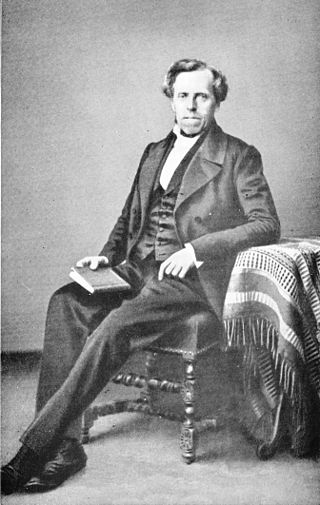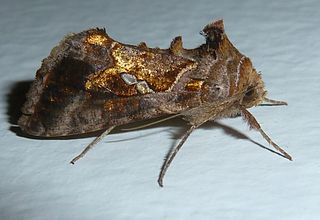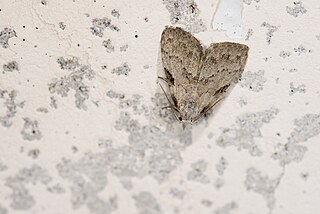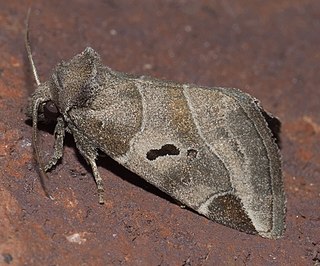
The Noctuidae, commonly known as owlet moths, cutworms or armyworms, are a family of moths. They are considered the most controversial family in the superfamily Noctuoidea because many of the clades are constantly changing, along with the other families of the Noctuoidea. It was considered the largest family in Lepidoptera for a long time, but after regrouping Lymantriinae, Catocalinae and Calpinae within the family Erebidae, the latter holds this title now. Currently, Noctuidae is the second largest family in Noctuoidea, with about 1,089 genera and 11,772 species. This classification is still contingent, as more changes continue to appear between Noctuidae and Erebidae.

The Drepanidae are a family of moths with about 660 species described worldwide. They are generally divided in three subfamilies) which share the same type of hearing organ. Thyatirinae, previously often placed in their own family, bear a superficial resemblance to Noctuidae. Many species in the drepanid family have a distinctively hook-shaped apex to the fore wing, leading to their common name of hook-tips.

Francis Walker was an English entomologist. He was born in Southgate, London, on 31 July 1809 and died at Wanstead, England on 5 October 1874. He was one of the most prolific authors in entomology, and stirred controversy during his later life as his publications resulted in a huge number of junior synonyms. However, his assiduous work on the collections of the British Museum had great significance.

Noctuoidea is the superfamily of noctuid or "owlet" moths, and has more than 70,000 described species, the largest number of for any Lepidopteran superfamily. Its classification has not yet reached a satisfactory or stable state. Since the end of the 20th century, increasing availability of molecular phylogenetic data for this hugely successful radiation has led to several competing proposals for a taxonomic arrangement that correctly represents the relationships between the major lineages.

Achille Guenée was a French lawyer and entomologist.

The Noctuinae are a subfamily of the family Noctuidae, and is composed of moths. The larvae of many species feed on roots or stems of various grasses. Some are generalist feeders which makes them potential pests.

Acontiinae is a subfamily of bird dropping moths in the family Noctuidae. There are more than 50 genera and 430 described species in Acontiinae, found worldwide in temperate and tropical climates.
Hadeninae was formerly a subfamily of the moth family Noctuidae, but was merged into the subfamily Noctuinae. The tribes Apameini, Caradrinini, Elaphriini, Episemini, Eriopygini, Hadenini, Leucaniini, Orthosiini, and Xylenini were moved from Hadeninae to Noctuinae.

Amphipyrinae is a subfamily of owlet moths in the family Noctuidae. There are more than 50 genera and 210 described species in Amphipyrinae, although the classifications are likely to change over time.

The tomato looper or golden twin-spot moth(Chrysodeixis chalcites) is a moth of the family Noctuidae, subfamily Plusiinae. It mainly lives in southern Europe, the Levant and tropical Africa, but can be seen migrating across much of Europe. In 2013, it was spotted in Canada. It is an important horticultural pest in New Zealand.

Eucarta virgo, the silvery gem, is a moth of the family Noctuidae. The species first described by Georg Friedrich Treitschke in 1835. It can be found in south, southeast and central Europe.

Manoba is a genus of moths in the family Nolidae. The genus was first described by Francis Walker in 1863.

Hadena confusa, the marbled coronet, is a species of moth of the family Noctuidae. It is found in Europe, North Africa and West Asia and Central Asia.

Heliothinae is a small, cosmopolitan subfamily of moths in the family Noctuidae, with about 400 described species worldwide. It includes a number of economically significant agricultural pest species, such as Helicoverpa armigera and Helicoverpa zea.

The Erebidae are a family of moths in the superfamily Noctuoidea. The family is among the largest families of moths by species count and contains a wide variety of well-known macromoth groups. The family includes the underwings (Catocala); litter moths (Herminiinae); tiger, lichen, and wasp moths (Arctiinae); tussock moths (Lymantriinae), including the arctic woolly bear moth ; piercing moths ; micronoctuoid moths (Micronoctuini); snout moths (Hypeninae); and zales, though many of these common names can also refer to moths outside the Erebidae. Some of the erebid moths are called owlets.

Stiriinae is a subfamily of owlet moths in the family Noctuidae. There are more than 20 genera and 130 described species in Stiriinae.

The Erebinae are a subfamily of moths in the family Erebidae erected by William Elford Leach in 1815. Erebine moths are found on all continents except Antarctica, but reach their greatest diversity in the tropics. While the exact number of species belonging to the Erebinae is not known, the subfamily is estimated to include around 10,000 species. Some well-known Erebinae include underwing moths (Catocala) and witch moths (Thermesiini). Many of the species in the subfamily have medium to large wingspans, up to nearly 30 cm in the white witch moth, which has the widest wingspan of all Lepidoptera. Erebine caterpillars feed on a broad range of plants; many species feed on grasses and legumes, and a few are pests of castor bean, sugarcane, rice, as well as pistachios and blackberries.
Max Gaede was a German engineer and entomologist of international fame who described several hundred of new species of Lepidoptera, mainly African Noctuidae.
Emilio Berio was an Italian entomologist and lawyer.
Charles Boursin (1901–1971) was a French entomologist, born into a comfortable bourgeois Catholic family in Nantes. Having had a German governess, he spoke German from his earliest days and remained "perfectly" bilingual in both during his lifetime. He also spoke Hungarian and Russian. Despite his formal humanist education he showed an early interest in the natural sciences.















